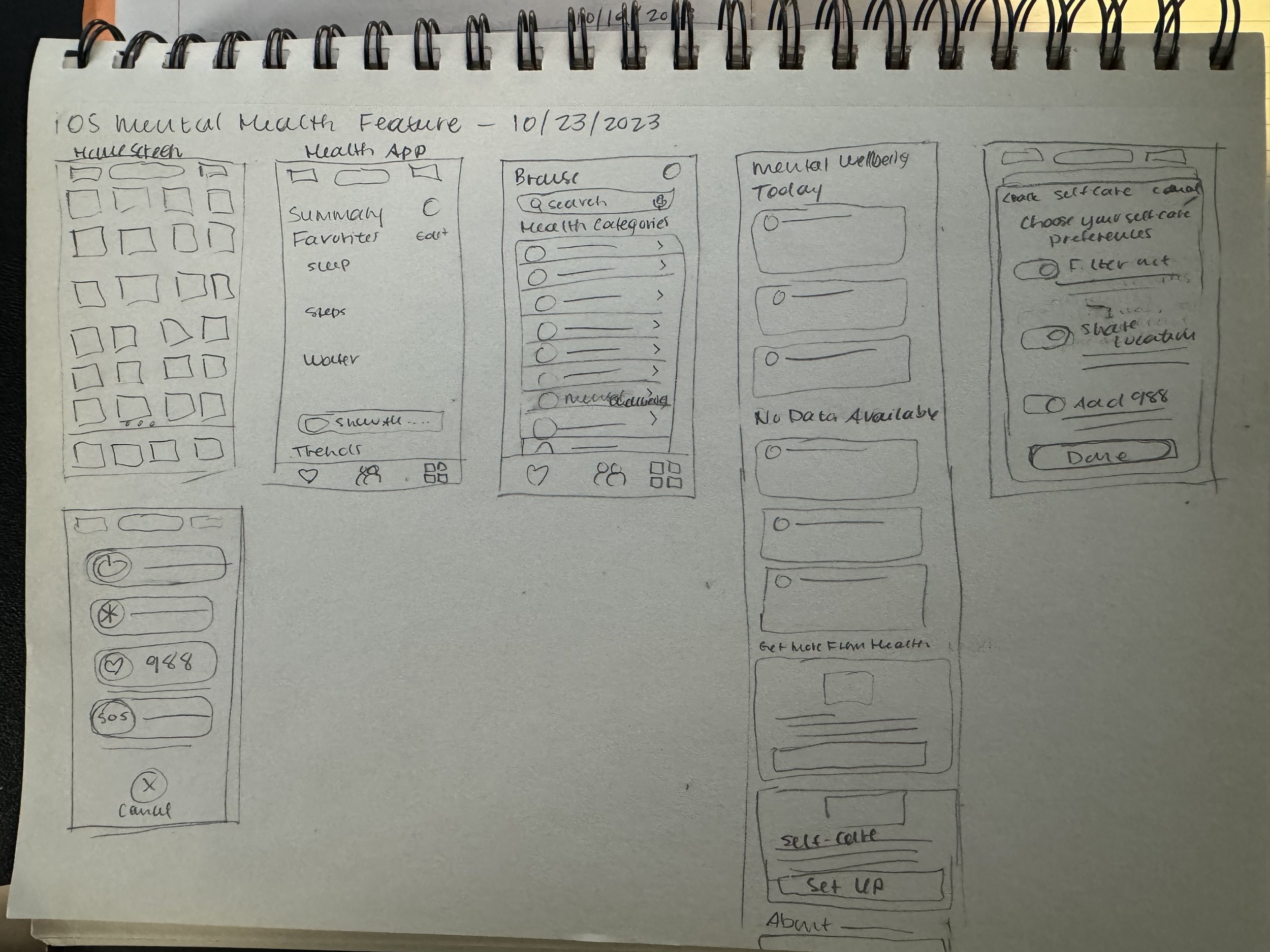iOS Mental Wellbeing
Self-Care
Before you begin, I’d like to give you a head’s up that the following case study mentions the following topics: mental health, overdose, and death by suicide.
According to the Center for Disease Control and Prevention (CDC), the rate of death by suicide in the US has risen by 30% from 2000-2022. Many adults in the US think about or attempt suicide: 12.3 million have seriously thought about suicide, 3.5 million made a plan for suicide, and 1.7 million have attempted suicide. We wanted to explore if our devices could save more lives if we made access to mental health services easier through our smartphones.
Mental Wellbeing is new with iOS 17.
I hypothesized that the Apple Health Mental Wellbeing sub-category could be more powerful to empower people to take charge of their mental health.
The constraints:
I gave myself a tight timeline of 3 weeks to add a feature to Mental Wellbeing
The tools I used:
Figma
Google Meet
After conducting user interviews, I asked:
“How might we empower someone in a emotionally sensitive time or a time of mental health crisis?”
Mental Wellbeing already features self-assessment tools to help build mental and emotional self-awareness. But what if someone already recognized the signs that it’s time for mental self-care?
After analyzing the data from interviews that I conducted, I ideated the key components for the self-care feature.
Location sharing came up as a life-saving feature from one interviewee. They bravely told a story of how sharing their location on their smartphone with a loved one signalled that there had been a suicide attempt via overdose after her location had stayed the same for more than 2 days.
Talking to someone was also a demonstrated approach to self-care as most users were or are currently still in talk therapy with a qualified therapist. But access to therapy isn’t equitable for everyone.
As a proactive choice, we also chose to include the option to filter out sensitive news topics since we have the ability to work with other Apple apps in the iOS suite to further empower users.
The key themes that came up during user research were:
• Access to help
• Confidence and trust
• Needs + tiers of intervention
Following Apple’s User Interface Guidelines, I generated some lo-fi ideas.
And then some hi-fi wireframes with a custom icon for the Mental Health Self-care Settings feature.
Overall, usability testing was a success.
Usability Goals:
Validate user’s ability to locate the “Mental Wellbeing” sub-category in the Apple Health app
Validate user’s ability to set up “Self-Care” preferences
Validate user’s ability to make a call to their regional crisis line
The pain points were primarily centered around iOS’ information architecture and challenges locating the Mental Wellbeing sub-category. Once users were in the correct sub-category, the test flowed smoothly and users engaged with the settings within the feature.
Usability Test Metrics
Completion Rate: 100% of tasks were completed
Error Rates: 0 errors
Time On Task:
Locating the “Mental Wellbeing” Sub-Category In the Apple Health App = 42 seconds (average)
Setting Up “Self-Care” Preferences = 2.75 minutes (average)
Making a Call To the User’s Regional Crisis Line = 10.8 seconds (average)
User Satisfaction (Out of a score of 5):
Locating the “Mental Wellbeing” Sub-Category In the Apple Health App = 4.4
Setting Up “Self-Care” Preferences = 5
Making a Call To the User’s Regional Crisis Line = 5
Based on testing, a few things we think the Mental Health Self-Care feature could benefit from in the future:
Option to remove social media icons from home screen
Ability to ask Siri to call the crisis line
Due to the sensitive nature of the project, I had to be very proactive about finding users to interview and to recruit for usability testing. I am endlessly grateful to the participants for their vulnerability. It was incredibly rewarding to work on a feature that was well received and has the potential to make a real and significant impact on human lives.
I hope that the iOS Apple Health Mental Wellbeing sub-category becomes a well-known and equitable tool to empower people and their mental health.
Thank you for reading the case study for my iOS Mental Wellbeing Self-Care feature.
I hope you’ll prioritize your self-care, too.
This project is dedicated to the memory of Colleen Braun.













